Musicarta Twelve-bar Piano Styles
Chromatic Sixths
All twelve-bar piano styles use chromatic thirds and sixths freely. The twelve-bar chromatic sixths are the inversions of the chromatic thirds you have already learnt, but they put the lower note on top, and so give you a whole new set of harmonising options.
The music for the first chromatic sixths study, Slippery Customers', is in your workbook. Here is the teaching video, with the MidiPiano performance.
The audio-only performance, with the download MIDI file reference, is directly below.
Slippery Customers
Here are the chromatic thirds you learnt before (in C) and their sixths inversions.
To avoid visual overload, no fingering is given here. The scale degree numbers shown are more important for your understanding of twelve-bar piano styles. Play through until you can ‘see’ the inverted sixths pattern in the keyboard.
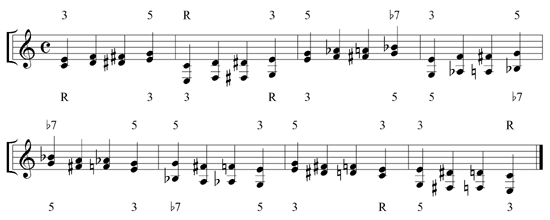
Do a thorough job! Work through the same pattern in F and G as well. Remember, the only whole-tone step is between the root of the chord and the next note up.
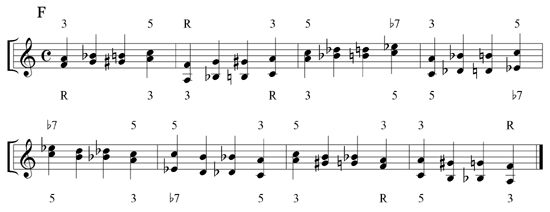
Some left hand roots have been put in the audio/MIDI examples. Parallel chromatic intervals like these can make you lose your sense of key centre.
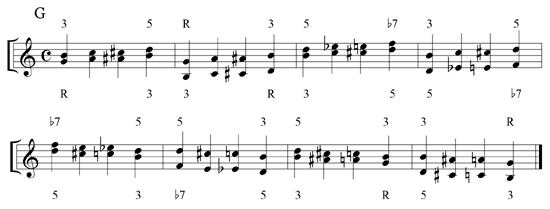
Then rehearse just the sixths. Don’t be drawn into reading every note. The landmark tones (root, third, fifth and flattened seventh) are indicated – work from those.
Keep reminding yourself that all steps are semitones, apart from the root of the chord (C, F or G) to the note above it.
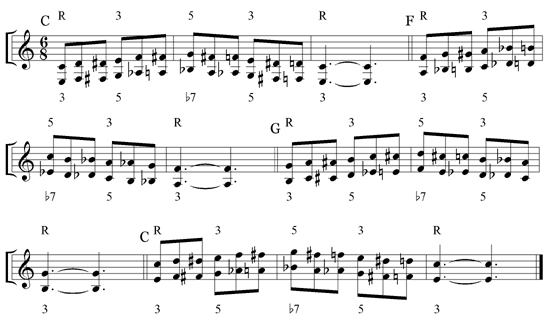
There is one run of sixths in Slippery Customers which is not quite true to pattern.

These are the top notes of the familiar thirds shown in the second half of the line, but harmonised with sixths below – that is, not inversions.
(In performance, the third of the C chord is played with the first of these sixths. It’s an unwritten rule that you must play the third of a chord straight away, or very soon afterwards, for the chord to sound full enough.)
Here is the Slippery Customers audio performance again.
Second chromatic sixths study
The chromatic sixths study is in the key of G, Our usual twelve-bar chords in G would be G, C and D (I, IV and V) but this study uses chords G, A and D – I, II and V (all with flattened sevenths). Hopefully, your ear will notice the difference. However, because of the chromatic sixths and the flattened sevenths, it is still unmistakably in the twelve-bar style.
The study splits the sixths up between the two hands. (You did something similar in the Moving Pair series.) Watch the teaching video several times, looking out for the sixths in the MidiPiano performance.
Here is the ‘skeleton music’, showing just the sixths played with the right hand and the roots in the left. The MidiPiano performance will show you the different hands clearly.

Then, split the sixths up between the hands and play the root in the right hand as well.

Then add as much of the syncopation as you
can. The music is in your workbook. Notice how, in the last bars, the left
hand helps out with some difficult next-door sixths in the right hand.
Other chromatic sixths riffs and licks
Perhaps the most familiar chromatic sixths twelve-bar lick is this favourite intro/outro construction.
Here it is as an introduction:

And as an ‘outro’ (opposite of an intro):
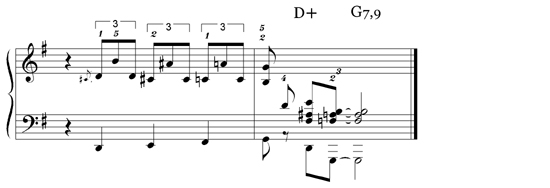
Once your ear is attuned, you will hear chromatic thirds and sixths seemingly everywhere in twelve-bar music. They are a very fruitful resource for ‘just doodling’ twelve-bars at the keyboard bars and will give your playing an authentic and knowledgeable sound.
|
OUT NOW! |
THE MUSICARTA BEAT & RHYTHM WORKBOOK At last! An effective approach to keyboard rhythm & syncopation skills. Learn more! |
ONLY $24.95! |
TWELVE-BAR |
The MusicartaA methodical approach to keyboard syncopation for
|
PUBLICATIONS
exciting keyboard
creativity courses
CHORDS 101
WORKBOOK

~HANON~
video course

Musicarta
Patreon
PENTATONICS
WORKBOOK
video course

Creative Keyboard
video course

BEAT AND RHYTHM
WORKBOOK

- Volume 1 -

12-BAR PIANO
STYLES WORKBOOK

MUSICARTA MODES
WORKBOOK

PIANO STYLE

CANON PROJECT
video course

VARIATIONS
video course


- Piano Solo -
video course

- Piano Solo -


YouTube playlists





 THE LOGO
THE LOGO
